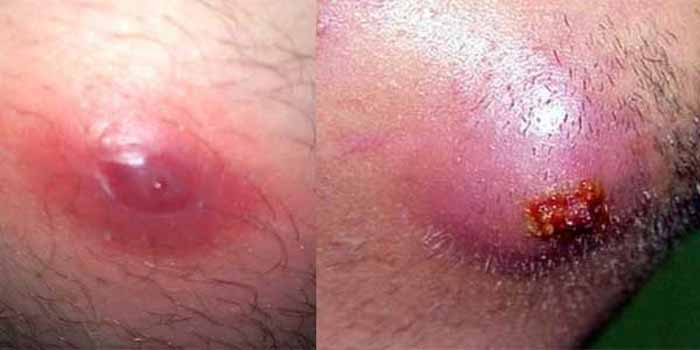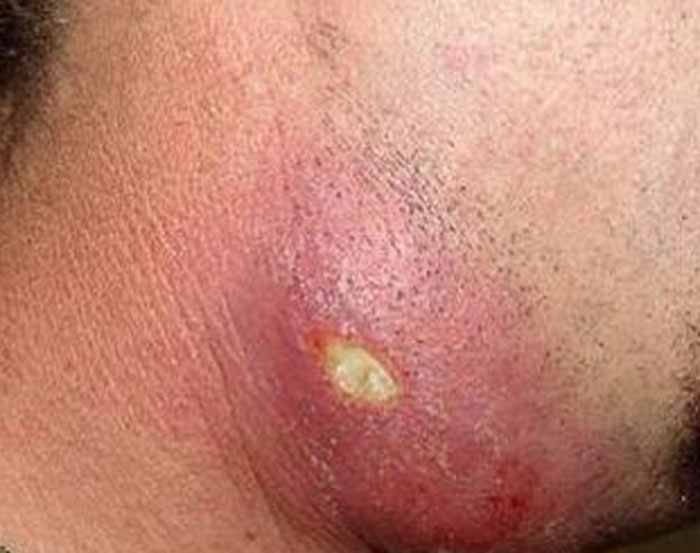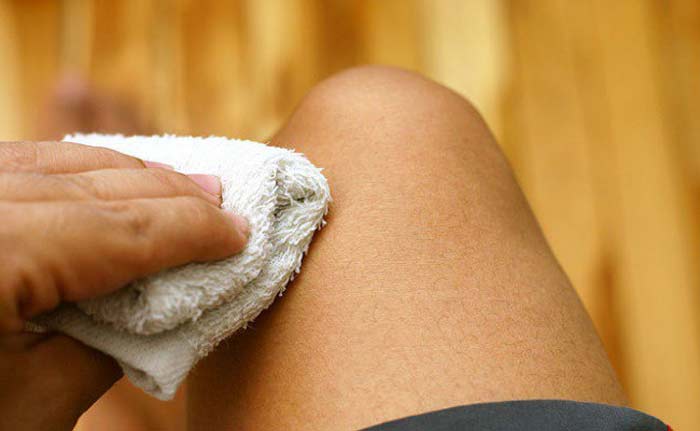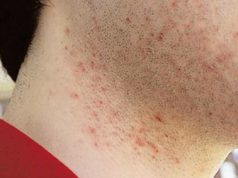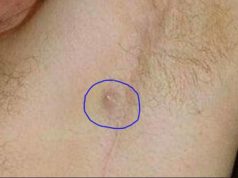Ingrown hair cysts are in most cases are result of infected hair follicle. These cysts can be painful buried deep under skin. Read on to find out the causes, symptoms, treatment, home remedies, what to do if it wont go away, differences between ingrown hair and a cyst, other types of cyst and more
Ingrown Hair Cyst? Ingrown Hair or Cyst-Differences
Ingrown Hair cyst under skin pictures & meaning
Having an ingrown hair is a hurtful and cumbersome thing. It bugs the mind when you have a follicle growing toward the wrong direction into the skin instead of out of it.
It not only may lead to stress and depression, but also infections and other complications. It can grow deep and cause more discomfort and involves a hair follicle penetrating the dermis.
When efficiently long to curl, it may curl under the skin to form a bump or ball of rolled intertwined hair. This may be hard and excruciatingly painful to pull out. With time, the ingrown hair develops into a complication manifesting as a mass under the skin which is a fluid filled sac.
Further Reading:
The sac and the mass thickens the skin and forms a cyst. A cyst is a fluid filled cavity containing either air or liquid. An ingrown hair cyst is at times referred to as a trichilemmal, isthmus-catagen or pilar cyst.
If you can address the matter before the cyst stage you will have saved yourself big time and prevented the agony and cost accompanying ingrown hair cysts.
Pictures
Ingrown hair or Cyst? What are the differences
There is so much similarity between ingrown hairs and cysts. This is the key reason why there is so much confusion in the two. Both cause uncomfortable pockets of fluid under the skin and can lead to a buid up of lumps that are visible on the surface. Both of them still can occur on various parts of the body. They differ in terms of appearance, symptoms and causes.
The growth of hair may meet folding and begin growing into the skin before getting to the surface. The hair grows back towards the inner skin, fluid often building up around the area and hence ingrown hair resulting.
There is a skin growth that resembles a blister or pimple and it may be painful and even itchy especially when it gets pus and forms an abscess.
On the other hand, cysts are masses that come from more uncontrollable factors like tumors, infections, inflammatory ailments and at times genetic conditions.
Further to that, a cyst may grow to become larger than an ingrown hair. They may also grow inwards further in the body organs and around the vital organs.
The treatment options for cysts an ingrown hair also differ. In the case of an ingrown hair, releasing it from the trapped state under the skin is the most beneficial.
This can be done by the help of tweezers and or even laser therapy. Cysts are treated using fluid drainage or a surgery in other cases. Antibiotics can be used in the case of infections that come from cysts, although warm compress can also help in reducing the pain.
Ingrown Hair Cyst vs Other types of Cysts
Following is a brief discussion on other types of cysts and how they are different from ingrown hair cysts
As mentioned earlier in this material, a cyst is a sac-like pocket of tissue that has fluid: air or liquid or any other substance. You may develop a cyst almost anywhere in your body including the viscera and on your body.
Those that occur in the viscera includes one common cyst in women known as ovarian cysts such as those that result from polycystic ovary syndrome (PCOS). The fortunate thing about cysts is that most are benign and therefore are non-cancerous.
Just how do your recognize a cyst when you have one? They appear as a bump on your skin feeling like a small lump growing just under your skin. The typical cyst of an ingrown hair grows slowly and has a smooth surface when touched. More to the signs and symptoms are discussed further in the following sections of this material.
Cysts are not normally problematic unless they are infected, have grown to be very large, impinge on a nerve or vasculature or occurs in a sensitive area or one that is pre-exposed to movement such as the armpits and in between the thighs.
There are a variety of cysts that may be confused with ingrown hair cysts.
Sebaceous cysts
Do not confuse ingrown hair cysts with sebaceous cysts though one may lead to the other. They often form within hair follicles and form due to a rupture in the sebaceous glands. Physiologically speaking, hair follicles do not lead to blockage of ducts since they grow holistically through their pore.
The problem originated from the glands or ducts themselves. Just as acne develops with possession of a relatively high number of oil glands, infection by Propionibacterium acnes (P. acnes) bacteria or excessive keratinization (deposition of protein keratin), sebaceous cysts may develop in this fashion from an ingrown hair cyst.
This cyst can also be caused by an inherited condition known as Gardner’s syndrome. Gardner syndrome is a subtype of familial (inherited) adenomatous polyposis that causes non-cancerous tumors in organs such as the skin in the form of sebaceous cysts or epidermoid cysts (Cancer.Net)[1]. Sebaceous cysts are less common than epidermoid cyst.
Epidermoid cysts
These cysts are made of protein called keratin and fat. The deposition of keratin on areas such as the face, neck or arms leads to their formation. Epidermoid cyst may occur due to acne or other skin injuries that leads to wound healing and therefore keratinization.
At times they may form because of inflammation around hair follicles and thus identified as pilar cyst (WebMD). Pilar cysts are the ingrown hair cysts you have heard of. It generally does not hurt, but becomes tender, painful and red when it is infected.
As you have learnt, this cyst develops into an ingrown hair cyst if it involves a hair follicle. This cyst too develops from around the cup in which the follicle grows, the infundibulum.
Pilar cyst[2]
They are erroneously known as sebaceous cysts. You can also call them trichilemmal cysts. They are usually lined by stratified squamous epithelium similar to the isthmus of the hair follicle hence the synonym isthmus-catagen.
The isthmus is the segment between the insertion of the erector pili muscle and the sebaceous gland duct, where no inner root sheath exists. Ingrown hair cysts develop in this manner with trichilemmal keratinization resulting in the formation of cyst wall[3].
Pilonidal cyst
These occur when lose hairs become embedded in the skin as a cyst near the top of the buttocks or bum. They are filled with skin debris, body oils and hair among other matter.
According to Mayo Clinic[4], chronic infections in these cysts might increase your risk of acquiring a sebaceous cyst. Pilonidal cysts are also a subtype of epidermoid cysts. It is common to find hair follicles in pilonidal cysts but they are still different from pilar cysts.
Chalazion
These occur as non-cancerous on eyelids when the oil gland is blocked. It is a lump in the eyelid that resembles a stye but larger and may not hurt. Like a stye, it is also caused by an infection.[5]
Stye
This is a lump that is red and tender caused by an infection on the eyelid. It mostly occurs along the edge of the eyelid. When it occurs inside the eyelid, it is then known as an internal hordeolum.
Ganglion Cyst
They are also benign forming mostly on your wrist, hand or feet. They however, unlike other cysts, occur along a tendon sheath. They are more common in women than in men.
Causes of Ingrown Hair Cyst
There are a variety of reasons for the occurrence of ingrown cysts in various parts of the body including groin area, armpit, inner thighs, neck etc.
The causes range from shaving, diseases and conditions and having curly hair.
Shaving
Shaving can lead to an ingrown hair. The last thing you would want to deal with after shaving is an ingrown hair. That is why you should invest well in the time you use to shave, the shaving tool and the after-shave care you assume.
If you do not perfect your stroke and invest in quality tools and an aftershave cream, then an ingrown hair will be your lesson.
The small razor bumps left and the possible burns irritate the skin, make you scratch to alleviate the itch and at the long end, hair embeds into the skin and grows inwards. This is why hair cyst may develop on the neck.
Waxing
This is a form of hair removal regarded as semi-permanent in which the hair is removed from the roots. It will prevent new hair from growing back for as long as four to six weeks later.
The problem with waxing is that when you pull the hair out very rapidly, it disrupts the lining to guide the next hair shaft and this may cause ingrown hair.
According to a New York dermatologist Neal Schultz, MD, waxing is the most common causes of ingrown hair. Waxing is a big culprit of ingrown hairs in the groin or thighs especially in women.
Failing to medicate after waxing or exfoliating procedures
If you experience ingrown hairs, you should purchase a cream such as one common Uni K Wax Roll-On. If you do not do this, it may lead to irritation and ingrown hair may complicate into cysts.
Not exfoliating
Not exfoliating regularly especially after waxing may lead to accumulation of dead skin cells. Pores will get clogged up and cause ingrown hair. Your last exfoliation should be at least two days before the wax service.
Clogged pores
Clogging of pores prevents hair growth. It may be caused by excess dirt, oil or keratin deposition and dead skin cells. This mostly occurs in acne vulgaris condition or excessive exertion of pressure around the bikini line preventing the ridding of oil.
Acne
Acne is pilosebaceous skin condition that occurs due to blockage of sebaceous ducts. This may be due to an infection that clogs up the ducts or hormonal variations in which androgens are in excess. During this, the growth line of hair shafts might be disrupted deterring the proper exit of hair.
Curly hair
The tendency to have ingrown hair may occur if you have curly hair. When the hair naturally grows backwards, it may penetrate the skin and grown inwards.
Pili multigemini
This is a malformation whereby there is a bifurcated or multiple divided hair matrices and papillae. This leads to multiple hair shafts within hair follicles. This might also lead to ingrown hair cysts. [6]
Symptoms
The following are some signs and symptoms of ingrown hair cyts:
- Inflammation – this occurs when your immune system responds to foreign body. In cysts, it results in secondary inflammation since its sac is formed of the product of healing after primary inflammation. Secondary is marked by infections to which your immune responds and again the accumulation of fluids triggers the response too.
- Purulent discharge – infection results in formation of pus as a sound of alar that there is an infection. The discharge might be green or yellow depending on the extent of infection.
- Pain – inflammation is accompanied by pain as there is an extensive mobilization of pain mediators to the site alongside inflammatory mediators. Stretching of the skin and whether the sac is seated on a nerve might also cause more pain. It may be tender to touch too.
- Irritation – itchy feeling is what you feel when your body in response to pain, releases certain mediators that force you to scratch, induce pressure and hamper transmission in nerves. The wound healing process is normally accompanied by itchiness.
Ingrown Hair Cyst Removal
Removal
You can remove the hair cyst using tweezers though this is dependent on a number of things. You can remove newly formed hair by simply poking the top layer of the sac to target the hair. If it is not a new case, then the hair you have might be longer and possibly curled. This will require surgical removal.
Surgical
Surgical removal of an ingrown hair cyst is normally the last resort. This procedure is normally reserved for recurrent ingrown hair cysts and those that do not respond to treatment. There are a variety of surgical procedures that would be undertaken including:
- Laser surgery – this procedureuses laser light to remove diseased tissues or treat bleeding blood vessels. It would work well with increasing skin cells turnover.
- Surgical epilation – this is done in case of a deep or persistent ingrown hair cyst that manual/mechanical epilation using tweezers cannot remove. The doctor uses local anesthesia and uses epilation forceps to remove the cyst.
Popping out
It may be tempting to pop your cyst but this is one of the things you should avoid. Avoid bursting or pricking them yourself. Well, if you know how to do it, do it at your own risk. You would rather get help.
Here are the steps you can follow while popping it:
- First clean your palms then rinse well.
- Using a sterilized pin or tweezers for this purpose, prick the cyst. Makes sure you have some cotton wool in your hands.
- Drain the purulent discharge
- Pluck out any curled hair shafts.
- Clean the area well and use the cotton wool to prevent spreading the fluid to other parts.
Ingrown Hair Cyst Home Remedies
You can use one of the following methods:
- Warm compress –this helps in the alleviation of pain, reduction of irritation and itching. Use a clean soft cloth dipped in hot water and place on the area for about 10 times then repeat 3 – 4 times.
- Manual epilation – use tweezers to remove the ingrown hair. Make sure to clean the area around the follicle, warm compress and carefully pluck out the follicle without breaking it.
- Glycolic acid – get this from sugar by making a scrub. It helps encourage turnover of skin cells and promote faster healing. This is an exfoliation method whereby you could mix 5 teaspoonfuls of white sugar in a cup then add some essential oil such as olive oil. Apply on the affected area and rub circularly then rinse.
Dealing with Infected Ingrown Hair Cyst
There are medical remedies that could be used in the treatment of ingrown hair cysts. Your cyst could be treated differently depending on whether it is infected or is painful.
Pain and inflammation
Anti-inflammatory Medication
They reduce inflammation. You could find various delivery systems including topical creams. These should be used only on prescription and under the advice of a pharmacist since they could be tolerated and not be effective anymore.
They can also suppress your immunity if it is an infection making it worse. If you are using a cream, be careful not to spread the infection to other parts of the skin. You will be given either prednisolone or hydrocortisone.
Another option is paracetamol and ibuprofen. These reduce inflammation too and alleviate the pain. Care should however be taken if taking ibuprofen since it may cause stomach ulcers when used for long. Avoid aspirin especially if you have a blood disorder and in children under 18 years of age.
Infection
Creams or oral doses of antibiotics such as amoxicillin could be good for infections caused by Staphylococcus aureus which is the bug common for skin infections.
However, if it acne, then the options would be pegged on benzoyl peroxide and salicylic acid. Erythromycin, clindamycin and benzoyl peroxide are topical antibiotic creams, which may prove helpful in treatment of an ingrown hair cyst. Use these drugs as prescribed.
Tretinoin
This is a vitamin A. It is important for the renewal of skin cells laden by excessive deposition of keratin (keratosis). It reduces the hardness that comes with it. It should not be used by pregnant mothers as it is teratogenic.
Ingrown Hair Bump/Cyst won’t go away-what to do
If all falls to nothing do this, then it would be prudent that you start organizing for a surgery. This is the safest of all methods since a specialist will be able to handle it better and more safely. The surgery is a minor one and it would not take long to get the follicle out.
Sources & Citations
[1] http://www.cancer.net/cancer-types/gardner-syndrome
[2] http://emedicine.medscape.com/article/1058907-overview
[3] James WD, Berger TG, Elston DM. Andrews’ Disease of the Skin: Clinical Dermatology. 12th Ed. Philadelphia, Pa:Saunders Elsevier; 2015. 673.
[4] http://www.mayoclinic.org/diseases-conditions/pilonidal-cyst/basics/complications/con-20025007
[5] http://www.webmd.com/eye-health/tc/styes-and-chalazia-topic-overview#1
[6] Naysmith, L., De Berker, D. and Munro, C.S. (2001), Multigeminate beard hairs and folliculitis. British Journal of Dermatology, 144: 427–428. doi: 10.1046/j.1365-2133.2001.04047.x

